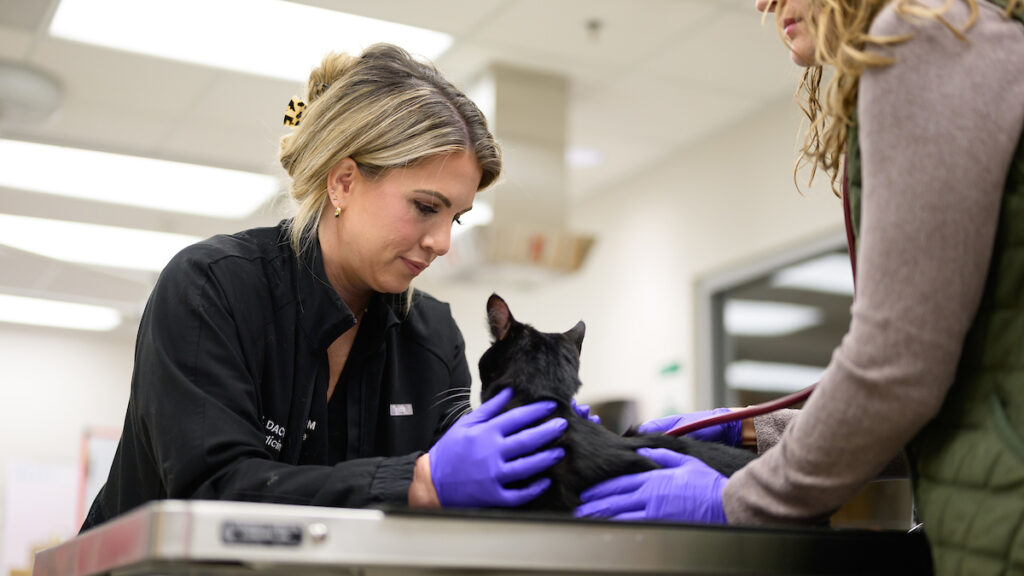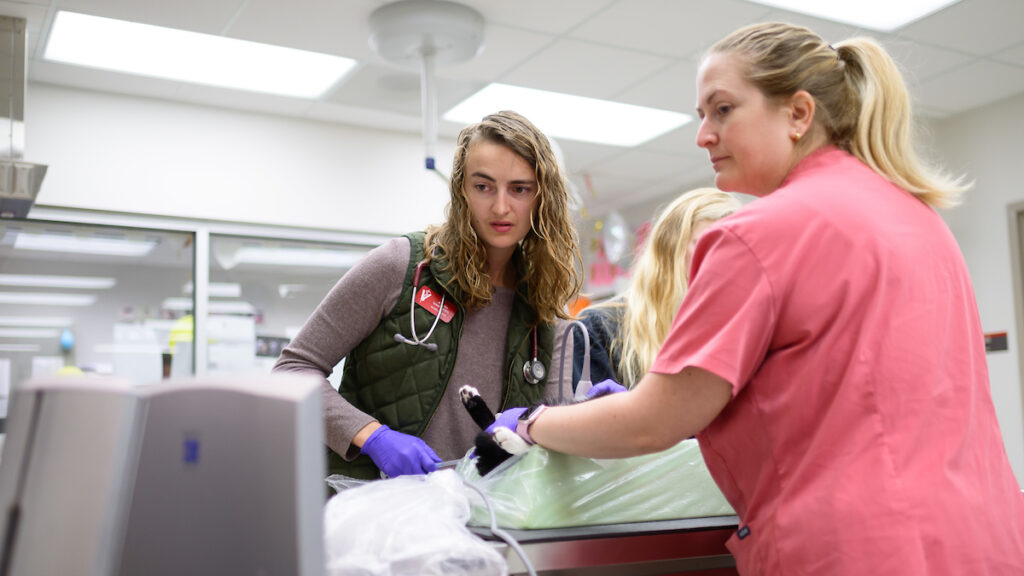On the Feline Idiopathic Cystitis Front, NC State Now Sharing, Caring and Launching a New Study
The NC State College of Veterinary Medicine has given the protocol of its groundbreaking low-dose radiation therapy study to veterinary centers across the country, has begun an FIC clinic at the Veterinary Hospital and is enrolling female cats in a new study.

Since an NC State College of Veterinary Medicine study showed last year that low-dose radiation therapy vastly improves hard-to-treat Feline Idiopathic Cystitis in male cats, the life-changing impact of that research has just kept expanding.
The study — led by Dr. Allison Kendall, an assistant clinical professor of small animal internal medicine, and Dr. Michael Nolan, the Randall B. Terry Jr. Distinguished Professor of Oncology — found the therapy so successful that the NC State Veterinary Hospital began offering it to clients during the trials.
In the ensuing months, numerous veterinary centers across the country have asked Kendall for the study’s protocol so they, too, could begin offering the innovative therapy. At NC State, Kendall has begun enrolling female cats with FIC into a new study and opened an FIC clinic on Wednesdays at the hospital.
“If you had asked me 10 years ago if we would ever have a treatment for FIC that would be this profound, I would have said, ‘No, it’s always just going to be difficult to manage.’ The fact that we are getting 90% complete resolution for a year, it’s unheard of. It’s incredible news.” — DR. SHELLY VADEN, professor of internal medicine
“These are client-owned cats,” says Kendall, whose specialty is nephrology and urology. “We have them come in on a Wednesday, and we do a consultation, discuss everything, and then if we decide that radiation is an appropriate treatment or next step for this cat, we will have them come back for the radiation treatment.”
More than 20 cats have been treated through the clinic so far, she says, noting that the hospital is tracking their progress.
Of the 19 male cats that participated in the initial study, only two have had a recurrence of their clinical signs. The painful condition, marked by a blocked urethra and usually is chronic, leaves affected cats straining to urinate, often outside their litter boxes, or unable to urinate at all.
“If you had asked me 10 years ago if we would ever have a treatment for FIC that would be this profound, I would have said, ‘No, it’s always just going to be difficult to manage,’” says Dr. Shelly Vaden, professor of internal medicine at NC State and president-elect of the national American College of Veterinary Nephrology and Urology. “The fact that we are getting 90% complete resolution for a year, it’s unheard of. It’s incredible news.”
The causes of Feline Idiopathic Cystitis are not well understood, though environmental stress and pain appears to be a main factor. Until the NC State study, which uses low-dose radiation therapy on the bladder, treating the symptoms and removing stressors were all veterinarians could do, and the available pain medicines aren’t very effective, Kendall says.
The idea for the study came from Nolan, who had seen low-dose radiation work really well in reducing pain in arthritis and other inflammatory conditions. He approached Kendall wondering whether the therapy could reduce pain in cats with FIC, too. The first cat enrolled in the study was treated with radiation in 2021 and has not had a recurrence.
In addition to the low recurrence rate among the participants, the cats’ owners also have uniformly reported improvement in their cats’ behavior as well, Kendall says.

“Every owner we have followed up with, one of the first things they tell us about is the behavior of the cat changing at home,” Kendall says. “We expected a little bit of that, but owners will say that their cats are much more social, that they walk around the house with their tail held high, that they are more affectionate, more interactive. We’ve had a lot of owners say they’re like a different cat.”
Kendall theorizes that the amount of pain FIC causes has been vastly underestimated. Now she is working with the NC State Veterinary Hospital’s Behavioral Medicine Service to develop a protocol for studying these results further.
“We now know that with the cats, with how much their behavior is changing, FIC is not just an annoying problem,” Kendall says. “These cats really were uncomfortable.”
In the ongoing study of female cats with FIC, four have been treated, with six more enrolled. Kendall hopes to study at least 15 female cats, which are less likely to develop the condition. More information about enrolling a cat in the study can be found here. Grants from internal NC State College of Veterinary Medicines sources, which funded the previous study, are paying for the new one as well.
One of Kendall’s own cats has FIC, so she brings an owner’s perspective to her work, too.
“I have a cat that’s pretty minimally affected, whereas a lot of these cats were so severely affected that I can’t imagine how frustrated those owners must have been,” she says. “Their cats were urinating on stuff on a daily basis. That’s why I think the study has been so groundbreaking, because it’s giving both the cat and the owner relief.”

Fourth-year veterinary student Angelia Laudermilch, left, and registered veterinary technician Megan Millman examine Pym Laflin at the Feline Idiopathic Cystitis clinic at NC State.


